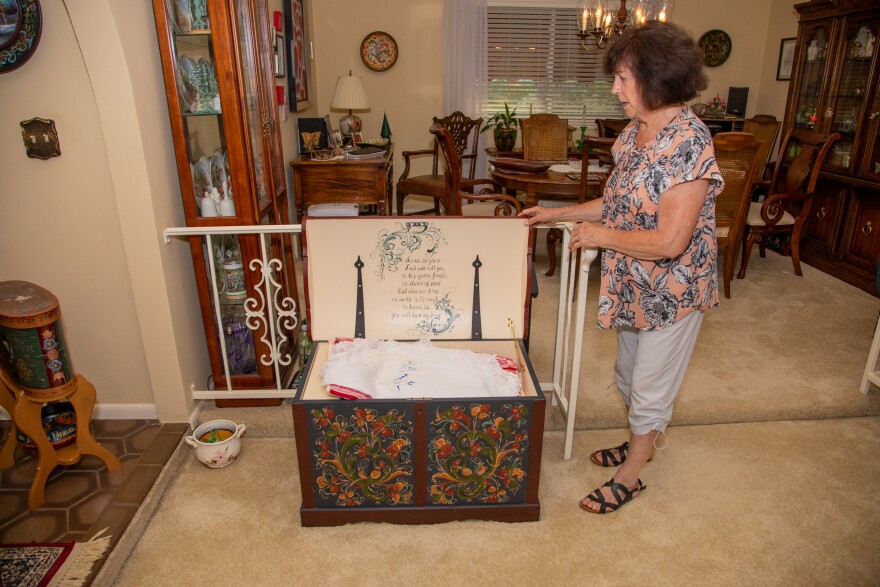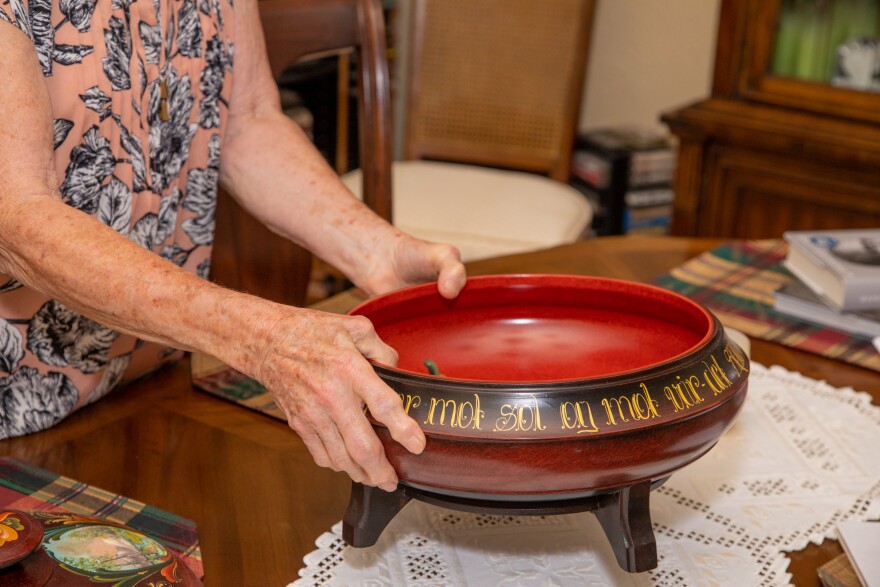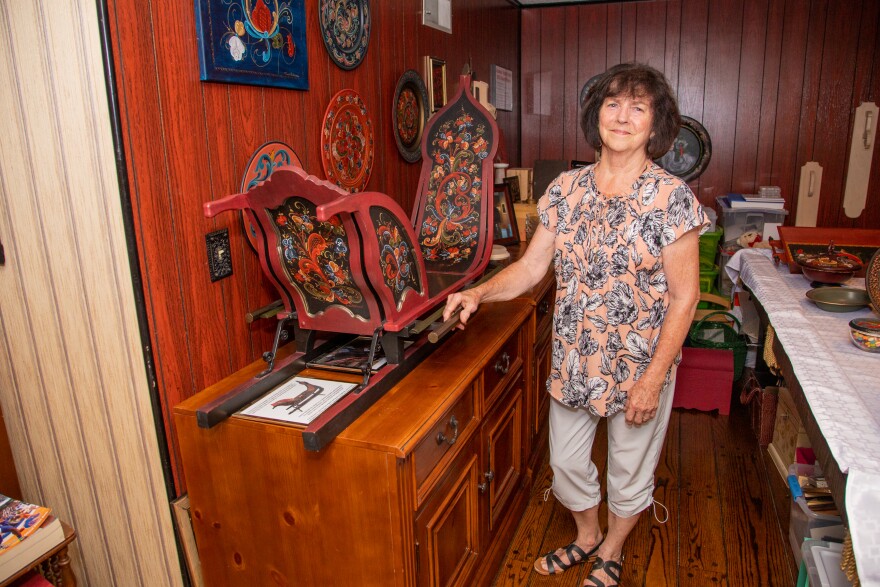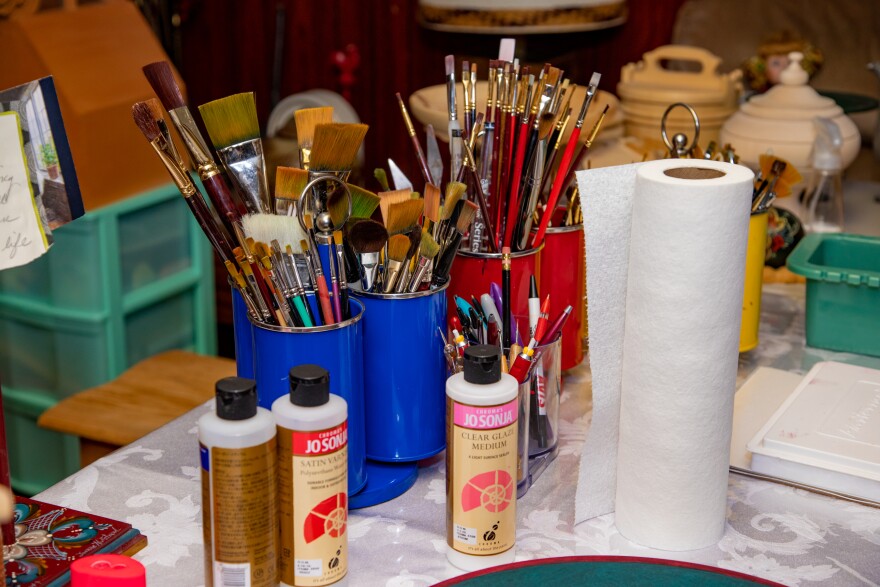Painted flourishes and fantastical blooms spring from bowls on the dining room table, platters hanging on the wall, a clock, candlestick holders and a large china cabinet in rosemaler Joanne Hultstrand’s Boise home.
“I like the colors and I like that you can paint on everything,” Hultstrand said of her craft.
The decorative painting known as rosemaling was popularized in Scandinavian countries in the 1700 and 1800s. In Sweden and Norway the organic brush strokes adorn church ceilings and home furniture in rural agricultural communities.
“They use every ounce of land that they can. Of course, many of them left. They couldn't support their family with the land,” Hultstrand said.
From 1820 to 1920 around one million Norwegians immigrated to the U.S., many to Wisconsin, Minnesota, bringing the decorative painting with them on trunks that held their dearest possessions.

Hultstrand’s Norwegian roots are two generations back, yet she grew up with the traditions and the language in her home, only speaking English at school.
“We lived on a farm in Wisconsin, but did not have much extra. I only know of maybe two families in that area that had a piece of rosemaling,” Hultstrand said.
Though the decorative painting was sparse in many midwestern immigrant homes, she remembers a fascination with it as a child.
“That is just a treasure, if you were fortunate enough to have somebody's trunk, like your grandmother or great grandma,” said Hultstrand, who didn’t grow up with any painted family heirlooms.
As a young woman, she moved to Idaho with her husband in 1958, and in 1991 she met another Wisconsin transplant, Shirley Peterich, who taught her the art of rosemaling.

“I fell in love with it right away. There was something about it, and being able to create,” Hultstrand said.
After several years in training with Peterich, she was encouraged to travel to visit Vesterheim, the National Norwegian-American Museum and Folk Art School. She took rosemaling classes from the numerous Scandinavian teachers who frequented the school.
Out of the different regional forms of painting, she landed on the Telemark style of Rosemaling, from central southern Norway. Norwegian teacher Sigmund Aarseth told her, “Joanne, you are free flowing so I want you to do Telemark.”
Thirty years later, she still paints Telemark rather than the more symmetrical and precise Gudbrandsdalen style from her family’s region of Norway.
For her continued dedication to her craft, Hultstrand was awarded the 2020 Governor’s Awards in the Arts by the Idaho Commission on the Arts, for Excellence in Folk and Traditional Arts. She mentored many students in her creative career, including five apprentices participating in the Idaho Commission on the Arts Traditional Arts Apprenticeship Program.

Rosemaling painters often say they connect with their Scandinavian heritage and family history through this artform. Hultstrand is no different.
Her basement houses her acrylic paints, brushes and rosemaling projects, in various stages of completion.
“I'm addicted to brushes for sure. The latest one comes out, I've got to have it,” said Hultstrand, touring the creative space.
Thick, wispy paint brushes help her sweep long organic strokes onto each piece. Hultstrand uses thin brushes to line the designs and then varnishes each object for a long life. She paints traditional wooden pieces like porridge and cake containers and boxes to hold sentimental objects.

She branched out from tradition, painting tin pans, a sleigh, even eyeglass cases. Her works are made mostly on commission but she also sells at art bazaars and cultural festivals. She has also exhibited her collection at folk art museums.
Every painting begins with a root that anchors the design, which Hultstrand says is the hardest part.
Scrolls, flowers and leaves flow from the root of the painting: red, black, green, ochre, blue and white accents. Each layer of brush strokes add depth and dimension to the kinetic motif. The patterns are instantly recognizable, yet each vary widely even within a single painting.

“You wouldn't want it all to be the same,” Hultstrand said.
Using a basic method and constraints of the set style, she also adds her own creative flair, approaching each piece with a fresh attitude, ready to solve any problem that may arise with a mix of spontaneity and carefully practiced technique. The symbolism of the art also resonates for her.
“I just love them. I love that it means something, family.”
Some paintings have sayings, advice or salutations that are reminders of community and the intimacy you share in a home. Simple enough to match anything, she’s found that her clients enjoy the uniqueness that a rosemaling piece brings.
“My thought was, this is our home. This is what we like. This is what I want the children to grow up with,” Hultstrand said.
She painted ornate trunks for each of her children, reminding them of their roots, the immigrant journey across the Atlantic to a new home. Hultstrand’s family will always have a reminder of the happiness rosemaling has brought her, a treasure indeed.
“It makes you feel good when you're painting.”
The artist is flowing with life advice, for family and professional relationships.
“It's just being open and honest with it and not doing it because everybody's doing it, but doing it because you love it. The neatest thing about it is meeting the people that love the work.”
This series is produced in partnership with the Idaho Commission on the Arts’ Folk and Traditional Arts Program, with funding support from Jennifer Dickey and Andy Huang, Dr. Suzanne Allen, MD and the National Endowment for the Arts.







